SITTING here with family and friends on a large wooden divan in a Samarkand chaikhana, sipping that good tea, and eating some local snacks … we were about to take in some of the city’s magnificent architecture. Tomorrow we would be going to the Registan, a great market where I could take a shot at doing some negotiating with Silk Road merchants renowned for their sophisticated bargaining.
The Silk Road
Built on even much earlier trade routes, the Silk Road was a well-established overland route by 200 BC, that primarily connected the Mediterranean and China. No surprise, a principal commodity of trade was silk goods. Of course anything else that would sell also found its way along the 4000 mile route, including spices, jewels, slaves and crafts of all kinds.
It was all about doing business, and the people of the Silk Road developed the infrastructure, business processes and skills needed to make business happen, in spite of vast distances, brigands, sand storms and, no doubt, rogue genies escaped from bottles (this region is straight out of The Arabian Nights).
Camel caravans carrying their riches could reliably stop at a network of caravanserais spaced about a day apart, where water and feed was available for the animals, the goods were protected in lockers and the merchants and cameleers could take a break, cut deals, and hear stories and the latest news about attacks on caravans, hordes, political assassinations, etc. – all while enjoying a good meal.
It was a natural conduit for ideas between East and West and had a formative effect on all civilizations it touched. Civilizations came and went, but trade is trade and the Silk Road lasted into the Middle Ages.
Today it’s generally the Central Asian part of the route (the ‘stans) that’s referred to as “The Silk Road”. Since the breakup of the Soviet Union, the region has become accessible again and is a remarkable place to visit. My wife Barbara, son Jack, and I had joined a group of friends to travel there. Our trip was led by another friend very experienced in Central Asia, Cristina from Argentina.
Tashkent
We all flew together via Air Uzbekistan from London, arriving in the Uzbek capital, Tashkent. There wasn’t a lot that we planned to do in this city, but there was a certain bit of important business to take care of. Banking.
We were taken by a bus (that we would learn to know so very well) to a black market money exchange outside town. There we were shown into the compound of a going concern, where we planned to exchange our crisp new $20 bills for stacks of Soms, the local currency. A young Russian banker with a fat briefcase full of Soms appeared and took his place at a table in the garden. We took turns sitting down with him in this pleasant environment, listening to the fountain and birds, and making our exchanges. When business was done, we were surprised to be invited into a dining area, where we were treated to a nice Uzbek lunch before hitting the road for Samarkand. A civilized way of doing business …
One of our goals in Central Asia was to experience the architecture there. The best is reserved for mosques and mausoleums (esp. those of greatly revered saints, teachers and famous rulers), and in some cases madrassas (schools).
Whether simple or magnificent, some are quite remarkable places that somehow provide a special atmosphere of quiet clarity. Some are truly gorgeous, inside and out: domed structures, superb tile work, carved pillars, pools, fountains, rose gardens – designed by the master masons who built them to provide something special for those who visit. We made a point of spending time in these places.
Samarkand
This location has been continuously inhabited since at least 700 BC, and was a substantial city by the time Alexander the Great conquered it in ~330 BC. Subsequently it was under control of various Persian, Turkic and Arabic rulers, until Genghis Khan happened by in 1220. Showing uncharacteristic restraint, he only slaughtered those who holed up in the city’s citadel and mosque – and then went on to conscript some 60,000 of the city’s remaining men and boys.
After recovering from this and a subsequent visit by another Mongol khan, things were relatively quiet until the conqueror Tamerlane, who had been born nearby, took over the place as his capital in 1370. The city continued to pass through the hands of various other rulers and eventually the Russians took control of the city in the mid 1800’s, and kept it until the dissolution of the Soviet Union in 1991. Now it’s open for business again.
While Tamerlane had been extremely ruthless and destructive in his conquests, in the case of his chosen capital Samarkand, he was a great supporter of the arts and lavished much wealth on the city’s architecture. Including his own tomb, as you can see.
After spending time taking in the city’s architecture, we were ready to move on to visit Samarkand’s Registan market (quite a piece of architecture, itself).
Before my foray into rug buying, I was lucky to get coaching from our friend Adam from London, who with his wife Nellie owns a rug-making business in Turkey, and knows the trade exceptionally well.
Once engaged with the Silk Road, something that quickly became clear was the significance of negotiating to people of this culture. You can be having dinner in someone’s home, and if you complement them on something – a vase, say – it’s immediately in play. The bargaining begins. At first this may seem somewhat materialistic, but turns out to be just the opposite. The point of the object isn’t to have it. The point is that it’s a medium of exchange – the basis of a relationship.
So in negotiations there, there’s a tendency to work toward a conclusion in which everyone is happy with the outcome. In the West, we think of “positional” negotiations (in which we take a price position and try to maintain it) and “non-positional or win-win” negotiations (in which we try to understand the objectives of both parties and mutually try to reach them). On the Silk Road, it’s a bit of both. And over the course of thousands of years they’ve become very good at it.
Essentially everyone you meet there is pretty good at it, and it’s a form of entertainment – both for the participants and, quite often, spectators.
And so it was when I settled down to my first bargaining session in the Registan. I’d found a nice little shop with carpets I liked quite a lot. The proprietor, a woman, had made me comfortable and sent one of her kids scurrying for tea, while the other kids, as well as some on-lookers, made themselves comfortable, too, and waited for the game to begin. The boy ran back in with a gimbaled tray full of glasses of freshly made tea, and we began the preliminaries of getting to know each other through discussions about our families, how things are in America and Uzbekestan, etc. She was very pleasant to be with and had a ready smile that showed off her mouthful of gold teeth – a sign of economic success there.
After asking to see a few carpets for a closer look, I asked the price of one. Her answer took the form I was to hear from one end of the Silk Road to the other: “Mister, for you first price X dollars” (or Y Soms – but they preferred dollars). First price? I’d never been in negotiations when anyone had said that.
They’d normally just say “$X”, as if that were that. And I’d of course say that we’d been looking around and had come to expect to pay $Z. And they’d say what they had on offer was better than what I’d seen elsewhere, etc. And we’d go through the usual dance. But it is first price, one of several descending prices that will be considered, so from a Silk Road viewpoint, let’s just start from there and then get on with the negotiations.
But I also have to confess that when she said “first price” the American in me was wondering why not just give me the last price – then we could get down to it and I could decide to buy or not. But that misses the point. There is no last price until the seller and buyer have reached it together. And how they reach it together is everything.
Moreover, how they reach it is a form of entertainment for all involved, and good exposure for the kids, who learn to be quite good at bargaining at an early age.
It’s not just business; it’s a national sport. They all want to watch a good match. They want your game to be savvy and creative. If they respect your moves and counter-moves, and at the end you’ve acquitted yourself well in their eyes, there’s hand shaking all ‘round, more tea, and you’ll be presented with a nice little memento of some sort – something hand made by the family perhaps. The exchange is complete and everyone walks away the better for it.
Let’s talk about some aspects of the game, and then take a quick look at a negotiating strategy.
Fun & Games
Contrary to the advice of many, I think it’s good to start by complimenting the merchant on his or her goods. After all, they’re professionals who take pride in what they made or purchased for resale, and it’s gratifying to them to know that their work is appreciated. And psychologically, it positions you less as an adversary and more as a fellow participant.
On the Silk Road, the seller sets first price. That’s the rule. In many other situations, it’s advantageous to make the first move yourself. Why? Because, as cognitive scientists have shown, it “anchors” the exchange, and negotiators will tend to think in terms of prices and offers closer to the anchor (that you’ve set) than to numbers set by someone else if given the opportunity.
Another point on first price. My experience: Silk Road men tend to start with a more aggressive first price than women, but women are often better than the men in the end game (they know how push your buttons with subtle gestures and fleeting expressions, making you feel like a jerk who’s committing some unmentionable sin, if you don’t agree to a final price they consider generous).
In any case, again on the Silk Road, it’s considered an insult to respond to a first price with an offer of 50% or less. If you think the first price too high for a first price, as a starting place, then just move on to something else.
It’s always good to do your homework before starting to bargain. There are many approaches, styles and principles of negotiation. One thing that’s common among them is 1) the need to establish your walk-away price – the specific price that would be high enough to cause you to walk away from the deal, and 2) your target price – the one you’re going to consciously try to negotiate – before you start negotiations. Poking around and finding out a rough typical price for the sort of rug (or whatever) you plan to get helps establish both 1) and 2).
Of course the merchant has also set his/her walk-away and target, and it’s very useful to have an idea of what that is. But they’re making it hard for you to know theirs and you’re making it hard for them to know yours. You mutually create a Gray Area obscuring your intentions.
So it’s good to initially negotiate for something less critical to you, just to get a sense for how your counterpart bargains, before you go for something important. If he/she’s very aggressive, you may wish to walk away from the first deal, to show that you can’t be pushed too far.
Moves & counter moves can be complex and subtle. If the negotiation isn’t coming together acceptably, take interest in another object and bring it into the deal, now bargaining for the pair. If you want, the 2nd object can be what you really wanted to purchase in the first place.
Normally you engage and let the process take its course, nudging the price down toward your target. But sometimes the price is just staying too high for the deal to come together and you have to break the pattern and do something that will either force the price down into the region you want, or end the negotiation.
Remember, this is a game and you may have to do something radical to shift how the game plays out. One method I stumbled on to bring a negotiation to a head was this:
A friend rushed in, interrupted the bargaining, and said “The bus is leaving – you’ve got to go, now!” I said “I don’t want to go. I’m in the middle of negotiating for this rug”. The friend said “You don’t have a choice”, etc. Now, I knew the bus certainly wouldn’t leave without me. But I said “OK, OK”, apologized to the merchant for the situation, and started walking out of the shop.
The merchant followed and, in the few seconds left to him, immediately dropped his price to what he thought I couldn’t refuse. The pattern was broken. The deal was done quickly, and I made my way to the waiting bus …
Bukhara
… which took us on to Bukhara. There’s archeological evidence that the Bukhara oasis has been inhabited as far back as 3000 BC. The city was taken over by Alexander about the same time as Samarkand (he wasn’t one to waste much time), and later spent a great deal of time under Persian rule.After a visit to special places of local interest, for example the mosque and tomb of Bahaudin Naqshband, the Bukhara Fortress and the great Minar of Kaylon, we proceeded to a converted caravanserai that today houses a Bokhari art and crafts center, where we negotiated with the artists for some very fine miniatures (Bokhara still retains much of its Persian heritage). We had a high regard for the artists’ work, and they definitely proved themselves tough negotiators.
But most negotiations were centered on Bukhara’s specialty of silk fabrics, the most famous of which is Ikat, made from elaborately and laboriously dyed silk strands. The photo, taken at a Bukharan silk works, shows silk in various stages, including the finished Ikat fabric.
Negotiating Strategy
There are a number of views of negotiation strategy, styles, practices, etc. I like to think of it this way: negotiation is a convergence process that takes place in a Gray Area.
The alternation of seller’s prices and buyer’s offers form two trajectories as shown below. If the curves converge, there’s a deal; if they don’t, there isn’t.
Because the buyer and seller are each creating a Gray Area for the other by obscuring their intended walk-away and target, each is giving the other a major barrier to reaching a satisfactory outcome.
As a generality, my strategy for getting past that barrier to a successful negotiation focuses on the rate of change of the seller’s successive prices in response to my counter-offers (that’s something I can see). In other words, I’m comparing the most recent price drop to the previous one. The difference between the two at each step reveals a great deal about the seller’s possible intentions at that point in the negotiation.
If the price drops in response to my offers are getting smaller fairly slowly, then I know the seller’s still in his comfort zone well above his target (and even further above his walk-away)
But when the drops are flattening out quickly (i.e. getting smaller), then either he is approaching his target price or is just acting like it and is testing to see if I’ll cave and start raising my offers to ensure there’d be a deal.
There’s no sure way of knowing which. So I’m careful to stick to my plan. Rather than quickly moving toward my target and trying to hold there, I consistently make modest increases in my offers.
This makes it difficult for the seller to read what my target is (no big change in my behavior).
Meanwhile, if he’s just testing and really wants to make a sale, he’ll eventually come around and start dropping more and our trajectories will eventually meet.
Or if he really is too far from my target and walk-away, then so be it: it wouldn’t be a good deal as it stands, leaving me two alternatives:
Either 1) bring something else I’d like to buy into the deal, allowing the seller to make a bit more out of the total sale, and be more willing to cut me some slack on the price of the first item, or 2) stop any further negotiations on the item and move onto something else (if the seller has any room left, he/she may be motivated to come back later and conclude the initial deal in a way more favorable to me).
In any case, if the trajectories appear to be moving to meet below my walk-away, then I’m in safe territory and can try to flatten out my curve more quickly and get closer to my target.
As I’m sure you can tell, you can’t take a literal approach to this game. This view of negotiations I’m offering here is about the exchange of money for some goods or services. Of course there are also important negotiations in which goods/services are exchanged for other goods/services – a.k.a. bartering. The principles are the same providing the negotiation takes place over several steps.
Postscript
In all, the Silk Road buying went well. We kept some of the rugs, etc. for ourselves and sold the others at an auction in Andalucía (where they greatly appreciate such items) for 8X what we paid in Uzbekistan.
Having bargained as a buyer, I next wanted to try my hand at the other side: negotiate as a Silk Road seller. We were leaving Uzbekistan for awhile, so I decided to take a shot at selling when we got to a suitable market in Turkmenistan. But, as Shaharazad would say, we’ll finish the story at another time …
____________________________________________
Readers are encouraged to add comments to this post.
And if you’d like to share or recommend the post, click on your preferred way in the left margin sidebar.
If you’re not currently being automatically notified when new posts are published, then please Follow Real Strategy (top of right hand column on this page), and indicate how you’d prefer to be notified.
For other posts of interest, look in the Smart Menu.
Photo credit: Tashkent Black Market Money Exchange, by Jack Carson. See his photostream at www.flickr.com/photos/jaxxon/sets/
Photo credit: Kaylon Square, Bukhara, by Euyasik in Wikipedia. See http://en.wikipedia.org/wiki/File:Kalon-Ensemble_Buchara.jpg
Photo credit: Silkworm Cocoons, Silk Thread, Ikat Fabric, Bukhara by Jack Carson. See his photostream at www.flickr.com/photos/jaxxon/sets/

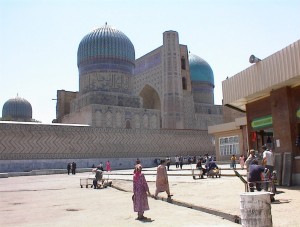
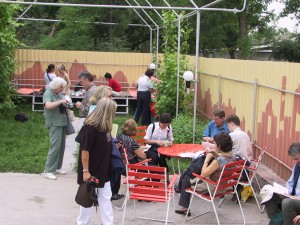
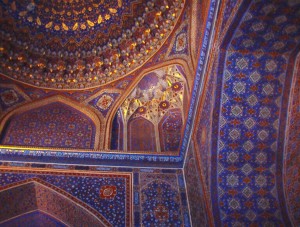
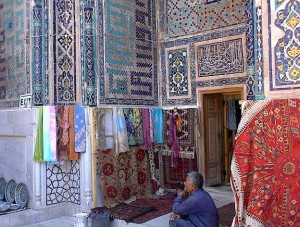
![800px-Kalon-Ensemble_Buchara[1]](https://www.real-strategy.com/wp-content/uploads/2012/04/800px-Kalon-Ensemble_Buchara1-300x143.jpg)
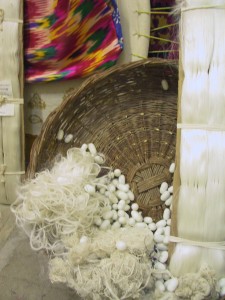
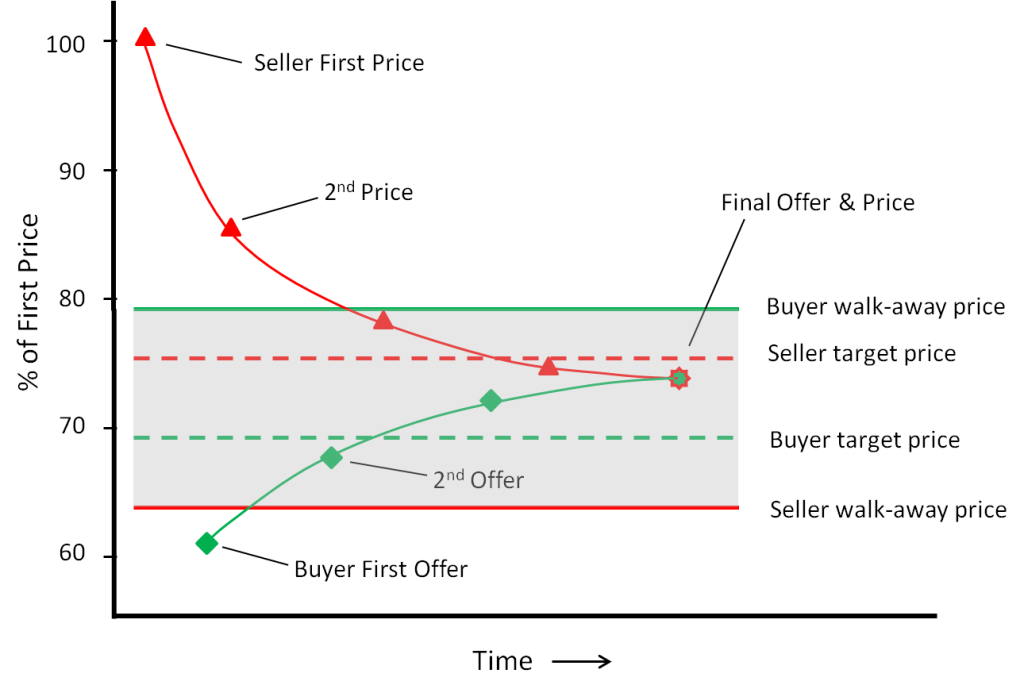





The problem you always face in negotiations is “asymmetric information” – Unfortunately, a rug dealer is an expert on rugs – construction, factors contributing to value, market supply, current market prices….., and you probably aren’t. So, it’s essential that you seek to you overcome this disadvantage through either lots of study and prep, or a novel strategy a friend of mine once faced. He was negotiating an oil deal with the newly appointed Minister of Energy of South Viet Nam. This official knew that he simply didn’t know as much about the oil industry as my friend. So, cannily, the official required my friend to provide him a “personal tutorial” on all aspects of the oil industry – BEFORE he would start actual negotiations. Through this two day tutorial, they both learned a lot about each other, developed personal trust – and subsequently concluded a very fair deal – one that probably wouldn’t have been achieved unless the official had a) recognized the asymmetry of information; b) admitted it; and, c) invited my friend to help provide a means for balancing their respective knowledge positions.
[Translate]
Information asymmetry is a big factor in negotiations, all right. Homework, homework. But having your counterpart be your teacher – that’s a real stroke. Wisdom triumphs over guile: hats off to the Minister. Humility at work.
[Translate]
I LOVE the solution of the Minister of Energy. That is a superb approach to removing adversarial barriers. This solution is out of the ordinary, out of left field you might say, a neat example of “lateral thinking”. Bill, will you be bringing “lateral thinking” into your discussions?
I was reminded of my own “bus is leaving!” negotiation story. Something very similar happened, only the bus was a plane, and it WAS going to leave without me if I didn’t bring negotiations to a close. I had my eye on a very colorful paper mache’ tea tray in Cabo San Lucas (not a practical item to be sure, just think if it got wet…, but covered with beautiful purple, red and yellow parrots, a beautiful addition to any home…mine hopefully!)
I had quite a number of pesos left from our vacation by the seashore of paradise. I should say, I had quite a number of pesos in “Mexican terms”. That is, it was not enough money to account for much if I were to convert them back into US dollars, but as cash in Cabo San Lucas it was plenty. My aim was to dispose of the cash before I got on the plane either in lining the pockets of the beggars waiting at the airport, or in buying myself a memory.
As the clock counted down to the moment we HAD to leave for the airport or else miss the plane, I begged to make just one quick stop at the shop which held that coveted and expensive bit of paper mache’. I rushed in and faced the shopkeeper. Upon recognizing me from my previous visits to his shop (I had eyed the tray before), the shopkeeper began the negotiation game. Being a clumsy American in a big hurry, I simply gave him my bottom line. He continued to engage in the game until I asked someone the time. Only moments before we had to go! I went white in the face. “No time to negotiate”, I said. “Here is all my money. Either take this and give me the tea tray, or I give it all to the beggars at the airport!”
The beautiful memory sets on display on our kitchen counter, well away from any water!
[Translate]
Very nice story. A time squeeze can be a real forcing function for bringing things to a conclusion, if both sides are motivated.
[Translate]
When you have played World of Warcraft for a longTime
[Translate]
Some really great posts on this web site , appreciate it for contribution.
[Translate]
Thanks – I hope you continue to enjoy the blog.
[Translate]